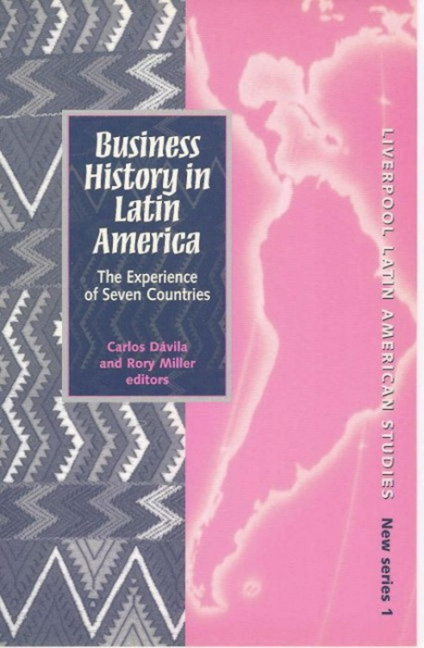Refine search
Actions for selected content:
26946 results in Economic history
3 - Minted Currency and the Bullion Market
-
- Book:
- Respectable Banking
- Published online:
- 04 July 2017
- Print publication:
- 15 June 2017, pp 52-87
-
- Chapter
- Export citation
4 - Credit Markets and Clearing Banks
-
- Book:
- Respectable Banking
- Published online:
- 04 July 2017
- Print publication:
- 15 June 2017, pp 88-123
-
- Chapter
- Export citation
Glossary of Technical Terms
-
- Book:
- Respectable Banking
- Published online:
- 04 July 2017
- Print publication:
- 15 June 2017, pp 209-234
-
- Chapter
- Export citation
Tables
-
- Book:
- Respectable Banking
- Published online:
- 04 July 2017
- Print publication:
- 15 June 2017, pp vi-vi
-
- Chapter
- Export citation
Acknowledgements
-
- Book:
- Respectable Banking
- Published online:
- 04 July 2017
- Print publication:
- 15 June 2017, pp xi-xiv
-
- Chapter
- Export citation
Appendix – English Mint Prices, 1158–1946 (Tables A.1 to A.7)
-
- Book:
- Respectable Banking
- Published online:
- 04 July 2017
- Print publication:
- 15 June 2017, pp 189-208
-
- Chapter
- Export citation
Index
-
- Book:
- Respectable Banking
- Published online:
- 04 July 2017
- Print publication:
- 15 June 2017, pp 273-279
-
- Chapter
- Export citation
1 - Introduction
-
- Book:
- Respectable Banking
- Published online:
- 04 July 2017
- Print publication:
- 15 June 2017, pp 1-8
-
- Chapter
- Export citation
Diversification and Internationalization in the European Single Market: The British Exception
-
- Journal:
- Business History Review / Volume 91 / Issue 2 / Summer 2017
- Published online by Cambridge University Press:
- 14 June 2017, pp. 279-299
- Print publication:
- Summer 2017
-
- Article
- Export citation
Novel market inefficiencies from early Victorian times
-
- Journal:
- Financial History Review / Volume 24 / Issue 2 / August 2017
- Published online by Cambridge University Press:
- 13 June 2017, pp. 143-165
-
- Article
-
- You have access
- HTML
- Export citation

Business History in Latin America
- The Experience of Seven Countries
-
- Published by:
- Liverpool University Press
- Published online:
- 09 June 2017
- Print publication:
- 01 March 1999
-
- Book
- Export citation
A century of monetary reform in South-East Europe: from political autonomy to the gold standard, 1815–1910
-
- Journal:
- Financial History Review / Volume 24 / Issue 1 / April 2017
- Published online by Cambridge University Press:
- 01 June 2017, pp. 3-21
-
- Article
- Export citation
FHR volume 24 issue 1 Cover and Back matter
-
- Journal:
- Financial History Review / Volume 24 / Issue 1 / April 2017
- Published online by Cambridge University Press:
- 01 June 2017, pp. b1-b5
-
- Article
-
- You have access
- Export citation
FHR volume 24 issue 1 Cover and Front matter
-
- Journal:
- Financial History Review / Volume 24 / Issue 1 / April 2017
- Published online by Cambridge University Press:
- 01 June 2017, pp. f1-f3
-
- Article
-
- You have access
- Export citation
Introduction to the special issue on the financial and monetary history of South-East Europe
-
- Journal:
- Financial History Review / Volume 24 / Issue 1 / April 2017
- Published online by Cambridge University Press:
- 01 June 2017, pp. 1-2
-
- Article
- Export citation

Penang Chinese Commerce in the 19th Century
- The Rise and Fall of the Big Five
-
- Published by:
- ISEAS–Yusof Ishak Institute
- Published online:
- 19 May 2017
- Print publication:
- 20 October 2015

Britain's Political Economies
- Parliament and Economic Life, 1660–1800
-
- Published online:
- 11 May 2017
- Print publication:
- 03 May 2017
Land ownership, tax farming and the social structure of local credit markets in the Ottoman Balkans, 1685–1855
-
- Journal:
- Financial History Review / Volume 24 / Issue 1 / April 2017
- Published online by Cambridge University Press:
- 09 May 2017, pp. 53-81
-
- Article
- Export citation
A Note on Sources and Dates
-
- Book:
- Britain's Political Economies
- Published online:
- 11 May 2017
- Print publication:
- 03 May 2017, pp xix-xx
-
- Chapter
- Export citation
10 - Conclusion
- from Part Two - Cases
-
- Book:
- Britain's Political Economies
- Published online:
- 11 May 2017
- Print publication:
- 03 May 2017, pp 306-326
-
- Chapter
- Export citation
